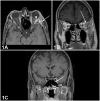Long-term outcomes of neoadjuvant intra-arterial cytoreductive chemotherapy for lacrimal gland adenoid cystic carcinoma
- PMID: 23582989
- PMCID: PMC3702633
- DOI: 10.1016/j.ophtha.2013.01.027
Long-term outcomes of neoadjuvant intra-arterial cytoreductive chemotherapy for lacrimal gland adenoid cystic carcinoma
Abstract
Purpose: To compare the long-term outcomes after intra-arterial cytoreductive chemotherapy (IACC) with conventional treatment for lacrimal gland adenoid cystic carcinoma (ACC).
Design: Retrospective case series.
Participants: Nineteen consecutive patients treated with IACC, followed by orbital exenteration, chemoradiotherapy, and intravenous chemotherapy.
Interventions: Analyses of the histologic characteristics of biopsy specimens, extent of disease at the time of diagnosis, diagnostic surgical procedures, incidence of locoregional recurrences or distant metastases, disease-free survival time, response to IACC, tumor margins at definitive surgery, and toxicity and complications.
Main outcome measures: Disease relapse, disease-free survival, and chemotherapeutic complications.
Results: Eight patients with an intact lacrimal artery had significantly better outcomes for survival (100% vs. 28.6% at 10 years), cause-specific mortality, and recurrences (all P = 0.002, log-rank test) than conventionally treated patients from the University of Miami Miller School of Medicine. These 8 patients (group 1) had cumulative 10-year disease-free survival of 100% compared with 50% for 11 patients (group 2) who had an absence of the lacrimal artery or deviated from the treatment protocol (P = 0.035) and 14.3% for conventionally treated patients (P<0.001). Likewise, group 2 was associated with lower cause-specific mortality than the institutional comparator group (P = 0.038). Prior tumor resection with lateral wall osteotomy, delay in IACC implementation or exenteration, and failure to adhere to protocol are risk factors for suboptimal outcomes.
Conclusions: Neoadjuvant IACC seems to improve overall survival and decrease disease recurrence. An intact lacrimal artery, no disruption of bone barrier or tumor manipulation other than incisional biopsy, and protocol compliance are factors responsible for favorable outcomes. The chemotoxicity complication rate is limited and manageable.
Copyright © 2013 American Academy of Ophthalmology. Published by Elsevier Inc. All rights reserved.
Conflict of interest statement
Figures





Comment in
-
Adenoid cystic carcinoma of the lacrimal gland: rare … lethal … cured?Ophthalmology. 2013 Jul;120(7):1311-2. doi: 10.1016/j.ophtha.2013.05.006. Ophthalmology. 2013. PMID: 23823505 No abstract available.
-
Does intra-arterial chemotherapy improve survival for lacrimal gland adenoid cystic carcinoma?Ophthalmology. 2014 Jan;121(1):e7-e8. doi: 10.1016/j.ophtha.2013.11.013. Epub 2013 Nov 20. Ophthalmology. 2014. PMID: 24268857 No abstract available.
-
Author reply: To PMID 23582989.Ophthalmology. 2014 Jan;121(1):e8-e10. doi: 10.1016/j.ophtha.2013.11.012. Epub 2013 Nov 20. Ophthalmology. 2014. PMID: 24268860 No abstract available.
References
-
- Lee DA, Campbell RJ, Waller RR, Ilstrup DM. A clinicopathologic study of primary adenoid cystic carcinoma of the lacrimal gland. Ophthalmology. 1985;92:128–34. - PubMed
-
- Font RL, Gamel JW. Epithelial tumors of the lacrimal gland: an analysis of 265 cases. In: Jakobiec FA, editor. Ocular and Adnexal Tumors. Birmingham, AL: Aesculapius Pub. Co; 1978. pp. 787–805.
-
- Font RL, Smith SL, Bryan RG. Malignant epithelial tumors of the lacrimal gland: a clinicopathologic study of 21 cases. Arch Ophthalmol. 1998;116:613–6. - PubMed
-
- Font RL, Gamel JW. Adenoid cystic carcinoma of the lacrimal gland: a clinicopathologic study of 79 cases. In: Nicholson DH, editor. Ocular Pathology Update. New York: Masson; 1980. pp. 277–83.
-
- Byers RM, Berkeley RG, Luna M, Jesse RH. Combined therapeutic approach to malignant lacrimal gland tumors. Am J Ophthalmol. 1975;79:53–5. - PubMed
Publication types
MeSH terms
Substances
Grants and funding
LinkOut - more resources
Full Text Sources
Other Literature Sources
Medical

